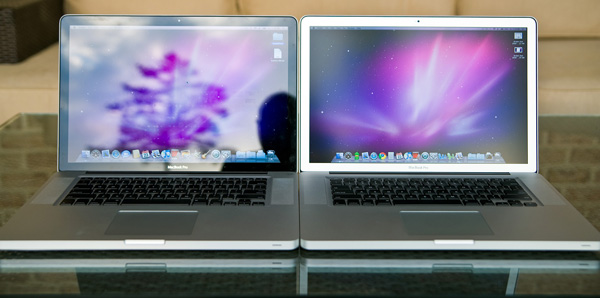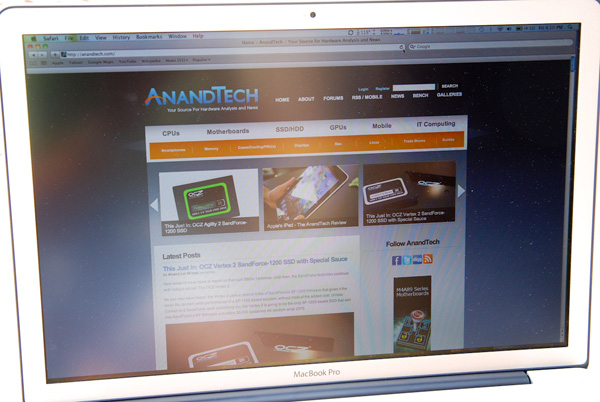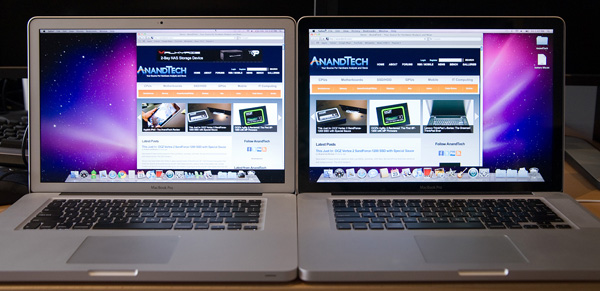Apple's 15-inch 2010 MacBook Pro: More Battery Life Tests, High Res Display Evaluated
by Anand Lal Shimpi on April 24, 2010 1:57 AM EST- Posted in
- Mac
- Displays
- MacBook Pro
- Arrandale
- Laptops
Outdoor Glare - To Matte or Not to Matte
You’re going to think something is wrong with me, but I actually prefer the glossy display of the MacBook Pro to the optional matte display. I rarely use my machine outdoors and the glossy display just looks nicer to me. The picture just looks punchier and more contrasty.
In Apple stores around the country however is an ultra high end preconfigured option: a 15-inch MacBook Pro with a high resolution, matte display. The higher resolution is something I applauded Apple for offering in the original review. The matte option however is an answer to a question I never personally asked.
Having a chance to use the high res matte display I’m going to have to stick to my original take on it. If you use the machine primarily indoors or outdoors but not in direct sunlight, go for the glossy display. The matte option really only makes sense if you plan on using it a lot outdoors in overwhelmingly sunny conditions.

As expected, glare outside isn’t overwhelming like it has the potential to be with the glossy display. In direct sunlight, it’s still occasionally difficult to read, even given the display’s very high brightness. In the shade, however, it’s very readable.

On the other hand, if your primary use scenario is indoors, there’s relatively little to gain so long as the occasional glare doesn’t distract. In practice, it’s continually changing glare from people moving behind you, or perhaps cars driving by while you work at a cafe, that has the largest potential for frustration with the glossy display. The matte option doesn’t eliminate it entirely, but mitigates most of the distraction.

The high resolution display is nice for productivity. You can fit more or larger windows on your desktop than you can with the default 1440 x 900 display. It’s not a huge increase in desktop resolution but it is nice.
It does make reading a bit more challenging thanks to the higher PPI of the display. For me personally it’s on the borderline. I do appreciate the extra desktop space, but I feel like browsing the web and reading is easier on the standard res screen. Perhaps the right balance is to use this for work and an iPad for leisurely consumption. Just kidding :)
I’d definitely recommend spending some time using the two screens in person before marrying one.
Final Words
For the most part, our conclusions about the 2010 15-inch Macbook Pro remain true. If you’re using an older MacBook Pro, the upgrade is well worth it. You’ll see a sizable performance boost and an increase in battery life as well. It’s only compared to the previous generation unibody MacBook Pro that you’ll find the upgrade tougher to justify. Not to mention the finicky switchable graphics and potentially more power hungry CPU can make real world battery life closer to the 4 - 6 hour range rather than the almost guaranteed 5+ hours you’d see on the previous generation.
If you properly manage when the discrete GPU is running (I smell a widget in the making), you can still see a tangible increase in battery life. It’s when you’re doing a lot of work or miss an application launching that turns on the dGPU that you’ll come away disappointed. Granted we’re still talking about great battery life given the size/performance of the notebook, it’d just be better if we could completely disable the discrete GPU.
As far as the glossy vs. matte, high vs. low res display options go. It depends on how good your eyesight is. Personally I'd opt for the high res, glossy setup. If I spent more time writing outdoors I'd probably go for the matte option. I also find that when my eyes are tired it's more difficult to read/write on the high res panel compared to the standard 1440 x 900 display.
















69 Comments
View All Comments
Anand Lal Shimpi - Saturday, April 24, 2010 - link
Thank you!Take care,
Anand
BanditWorks - Saturday, April 24, 2010 - link
I don't have the new MacBook Pros, but I do have a year old regular MacBook and while I was giving the new Adobe Flash 10.1 beta (the one that utilizes the GPU and CPU) I definitely saw a noticeable difference in battery life.As I wasn't doing anything that intensive on my MacBook I went back to the most stable version of Flash and it felt as if I had installed a newer, longer lasting battery instantaneously.
PS - Yeah, glossy screens suck big time. They're as tacky as a car with everything chromed out. They may be nice to look at when the screen is turned off, but for everything else they don't really serve much of a purpose in my opinion.
Computer Scooter Joe - Saturday, April 24, 2010 - link
Anand,You mentioned under windows the dGPU will always be on. In regards to this i have two questions:
1) Are there any heat issues with the dGPU being on all the time? Does the laptop get especially hot?
2) Do you foresee being able to enable graphics switching under windows? (Be it via Apple or a hack/3rd-party program)
I'm going to be attending University in the fall and i really like the aesthetics of the Macbook Pros; but these two questions have me a little worried. Having tried it, I must admit, I really do not like OSX at all (yes i know, blasphemy and all that), and i plan on bootcamping Windows 7. Price is not an issue; performance (or lack thereof) is what matters.
PS: To other commenters, please do not flame and start saying "Go buy Laptop X from this other company, Mac's are overpriced."
Thanks in advance.
Brian Klug - Saturday, April 24, 2010 - link
I can't speak entirely for the dGPU temperature in Windows 7 or boot camp installed OSes, but I do think I can talk a little about the dGPU temperature because I find myself switched on it a lot for what I do.I run a lot of Matlab related software on OS X (as I'm also a student), which requires an X11 instance. It seems that the X11 window system on OS X inevitably calls one of those core libraries that triggers the discrete GPU switching, and usually I don't notice until a good hour or so later that I'm on the dGPU. You'll notice that the battery life estimate changes. It doesn't immediately dramatically suffer, but it just seems shorter. Temperature creeps up a bit, but in practice for what I'm doing being switched on the dGPU doesn't raise internal temperatures more than 15 degrees F. I'd imagine playing games or doing some heavy OpenGL loads would change that though.
Apple has done a pretty good job with the thermal management from what I've seen thus far. I've had a couple of eyebrow-raising moments burning in the matte MBP I used for the display review section, but it's important to understand that temps up to 200F (while admittedly INSANE IMO) are well within the T_junction spec from the i7 spec sheet. The CPU will throttle long before you do any physical damage.
-Brian Klug
solipsism - Saturday, April 24, 2010 - link
Thanks for the review.I know that there is a Sys Pref option to keep the dGPU on all the time, but there is no power saving option to disable the dGPU completely. Did you find a secret switch, like in an PLIST file that will allow this to happen. This would come in handy for long bouts without a power cord attached.
etikka - Saturday, April 24, 2010 - link
Hi,Thank you for the review.
It would be great to have a review on the Macbookish HP envy 15". The looks are ok and it would be great to have a quad core CPU and working GPU switching under Win7.
MySchizoBuddy - Saturday, April 24, 2010 - link
offtopicSo Matlab is still using X11 on Mac OS X. I think they were working on a mac native version I guess they haven't released it yet
Brian Klug - Saturday, April 24, 2010 - link
See I agree completely! There needs to be a native version already. I haven't investigated it a lot, but it could be related to the 64-bit version I'm running. I'm on 2010a.I did some reading a while ago and the consensus was that Matlab on OS X just runs a LOT slower. Almost twice as slow in some cases. It isn't so much a problem stemming from the X11 window session rendering pipeline, but the java swing rendering pipeline. I'm puzzled why the platform is getting so little attention from the Mathworks when I see a huge population of students with exclusive mac setups. Oh well.
There's an awesome (bit dated though) thread here: http://www.macresearch.org/matlab-and-os-x
-Brian
ken.atwell - Friday, May 7, 2010 - link
I work for The MathWorks and a little while back I blogged about MATLAB on the Mac, including MATLAB's (diminishing) dependency on X11 . The performance of MATLAB on the Mac platform is also discussed, though you need to dig into the comments a bit (comment #12). If you are interested in these topics, you may want to visit:http://blogs.mathworks.com/desktop/2009/08/31/poun...
Ken Atwell
damianrobertjones - Saturday, April 24, 2010 - link
Thank you for the info, but, when are you going to review or run ANY articles with regards to the new Fujitsu, HP and Toshiba i7/i5 Tablets which are brand new and just out......Why don't they/haven't they been mentioned at all?